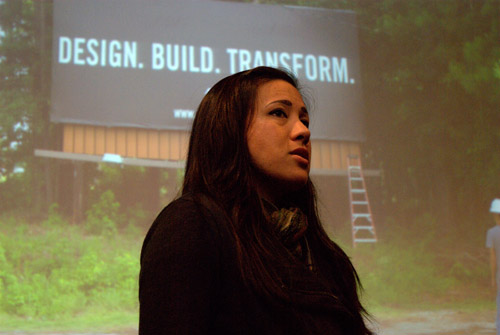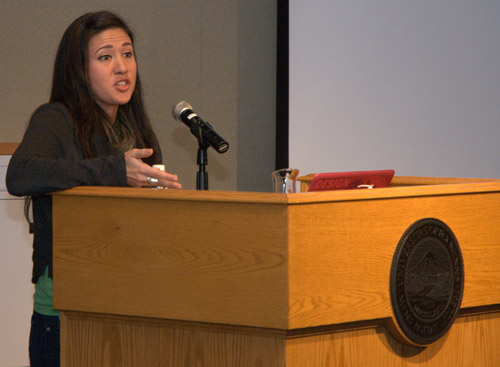
On January 28, 2011 the University of Oregon’s School of Architecture and Allied Arts Product Design program presented a lecture by Emily Pilloton. This lecture was made possible by a donation from the Ziba Lecture Fund for Product Design. Pilloton is the founder and executive director of Project H Design and high school instructor for Studio H in rural North Carolina. Pilloton came to the UO | Portland | White Stag block to deliver her lecture to a full house of students, faculty and staff, and members of the public.
Trained in architecture at UC Berkeley and product design at the School of the Art Institute of Chicago, Pilloton believes in the “process of design beyond what is just the product” and successfully launched Project H to empower communities and encourage the application of design “outside the design bubble to global issues that matter.” Pilloton’s background includes stints as the former managing editor of Inhabitat.com, prolific writing experience, ties to a native Californian youth, and the claim of being an “unwavering optimist.” Pilloton has been a pioneer in using design as a process rather than a product, and in being a community catalyst rather than an artifact. She whole heartedly believes that “smart design coupled with innovative education can change the world.” She is a Pop Tech social innovation fellow, has spoken at TED, and has appeared on the Colbert Report as well as recently publishing a book on the power of humanitarian design. Currently, Pilloton is located in Bertie, North Carolina. Since August 2010, she has been a faculty member of Pitt Community College in Bertie County, NC and teaches “the shop class” at the local high school where she runs the Studio H educational program along with partner, Matthew Miller.

Designing the curriculum for the high school shop class involved an approach that taught design as critical thinking. Pilloton recalls that her curriculum progressed as more and more creative and critical with the intent to produce something for the overall community benefit. The Pilloton-Miller Studio H team asked themselves what the community was lacking and what the community needed to survive. Their observations of the area led them to identify four key elements that needed to be addressed: citizenship, creativity, capital and critical thinking skills. Studio H fully embraced the idea of teaching design as a way to get excited about creative thinking and use this as the impetus towards community development.
Offering to the high school students an opportunity to earn one college credit and a guaranteed job at the school year’s end, Studio H is navigating a group of kids through two semesters of design, engagement and a final building project that will give paid employment. The implementation of allowing the students to earn one college credit for their work encouraged the young people to participate early in a directed college track for future plans.
Below is a video Pilloton produced about the beginning of Studio H:
[youtube]http://www.youtube.com/watch?v=q1hSZN1sdFo[/youtube]
While Pilloton spoke of the challenges of bringing her students “from zero to sixty” with key skills such as using a ruler and basic power tools, she successfully taught her students basic skills with a “boot camp-like” enthusiasm. Imparting the skills necessary to operate a table saw with safety, interpret a planned section and elevation, understand rudimentary color theory, employ safety skills, and have a familiarity with measurement systems and layout compelled the Studio H instructors to be consistently and constantly in tune with their students’ backgrounds and experience and be able to adopt work to mesh with and instruct the students’ abilities and comprehension levels.
Studio H embarked on a series of student-fabricated projects all with an end result of community benefit. The initial project involved designing and making a Corn Hole board for the simple, colloquial, and locally popular game. The boards were auctioned off for use in the community. The second project was to design and build a chicken coop. The Corn Hole board project introduced students to the graphic design process, how to use tools such as a drill press, and the importance of accuracy. From this initial experience, students graduated to having two chickens in the classroom as “the client” to observe and to develop ideas that would be used in the design/build process of a coop. The community of Bertie is economically dependent on poultry meat production as the sole source of income for the majority of the residents. Students had rarely seen a chicken as anything but a source of financial gain; youthful perceptions viewed poultry as animals raised by the tens of thousands in crowded inhumane warehouses and simply for slaughter. Pilloton challenged her students to “look at the chicken through a different lens” and to see a chicken in one’s backyard as a source of food in the form of fresh eggs and as a living thing to be kept healthy and happy. For three days the students “observed the client” and watched the chickens to determine their habits, lifestyle and health and well-being needs.
[vimeo]http://vimeo.com/19184007[/vimeo]
While Henrietta and Jezebelle, the two chickens, gained three architecturally designed coops, the 13 students involved in this project used this experience to develop structures out of reclaimed materials, to understand the confines of working within a strictly defined budget, and to acquire a firsthand knowledge of the power of design and building in tandem. As Pilloton says, she “pushed [her] students beyond what they knew to be a chicken coop.” The three coops that were created were ultimately donated to the community: one stayed at the high school, one went to a family-in-need, and one was installed in a local park.
The next Studio H project slated for building the summer of 2011 is the organization of a farmer’s market and the structure necessary to house this venture. At this point, the spring semester students are in the research phase travelling to other local farmer’s markets in their region. Pilloton decided on a farmer’s market as she realized there was a need in this agricultural community for such a venue. As Pilloton comments, this is a chance to “move design away from being product-driven to be process-driven,” and an opportunity to “focus on the process rather than the product and bring this to a place….”
Watch the discussion here:
[vimeo]http://vimeo.com/19461276[/vimeo]
As of yet, Pilloton’s “business card,” she says with a smile, reads “High School Shop Teacher” and, as she calls herself the unwavering optimist, she hopes her innovations help “build creative capital and that this becomes more of the norm….”
A quick update on Pilloton’s work with the chicken coops can be viewed at Studio H | Chicken Circus Delivered to the Parker Family, March 14, 2011.

Watch the podcast of Emily Pilloton’s lecture: [youtube]http://www.youtube.com/watch?v=hpVvRDwGr_w[/youtube].
story and photos | sabina samiee | Studio H videos provided courtesy of Emily Pilloton and Studio H
It’s great to have someone who is doing so much in design, and questioning so hard what design should be, be here, fun and approachable to others who would like to follow suit.
After the lecture I asked University of Oregon | Portland and fifth year Product Design Program student, Ruby Sprengle to comment. Ms. Sprengle had attended the lecture and spoke with Pilloton before the event. Sprengle’s quote illustrates the strong connection and accessibility afforded to our students when lecturers such as Pilloton present their work here as well as the benefit to having presentations that enhance our students’ experience and creative work.
“I actually got to sit down and talk with [Emily Pilloton] before the lecture. It was an honor to meet her. I have been following Project H for a while
now and Emily Pilloton has always been a hero of mine. I was worried at
first because they say “don’t meet your heroes” but she was so
down-to-earth and real with us. I love to see people following their
passions, throwing caution to the wind and DOING what they believe in.
Too many people have the tendency to talk-talk-talk about design. Emily
DOES it. She works hard and is changing people’s lives. I wish more
people worked with heart and passion like she does. I really identified
with her and was inspired to go out and do exactly what I want to do
with my life. Another thing, it was incredibly refreshing to hear a
YOUNG voice talking about design for once. Believe it or not, us
youngsters might actually know a thing or two.”
Kiersten: thank you for posting a comment!